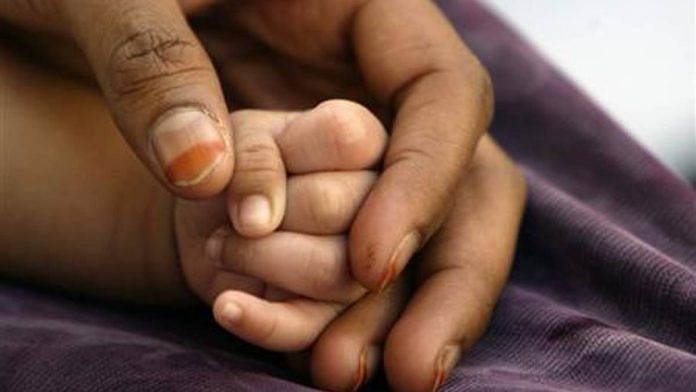New Delhi: Worried that the majority of districts in India may miss the target of bringing down the neonatal mortality rate (NMR) to 12 per 1,000 live births by 2030, the Indian Council of Medical Research (ICMR) has initiated a project to study possible interventions to ensure higher newborn survival in high-risk districts, ThePrint has found.
Neonatal mortality continues to remain high in India even though the NMR has come down from 26 per 1,000 live births in 2014 to 20 per 1,000 live births in 2020, according to the health ministry.
Every year about 5,00,000 newborns die in India before reaching the 28-day milestone, states a document released by the ICMR describing its project.
In 2014, the country had launched the India Newborn Action Plan (INAP), after endorsing the World Health Organisation’s (WHO) Every Newborn Action Plan (ENAP), in an effort to reach the United Nations’ Sustainable Development Goal (SDG) on NMR, which is 12 per 1,000 live births by 2030. Challenges, however, remain.
“Even though NMR in India has come down to 20 per 1,000 live births, there are huge disparities between states and districts, with some districts reporting eight to 10 times higher NMR than the district with the lowest NMR in the country,” a senior official in ICMR’s Implementation Research Division & National Health Research Priorities told ThePrint.
The ICMR’s project to increase newborn survival rate aims to have researchers find ways to achieve single-digit NMR in selected districts in India through the implementation of evidence-based, context-specific interventions in various settings and health systems.
The project has been designed in consultation with the government think-tank Niti Aayog.
“We want to study the usefulness of interventions specifically in every category of districts before implementing them,” the official said. “That’s because what is good in one district with severely high NMR may not be suitable for districts with only moderately high NMR.”
ThePrint has reached Rajiv Bahl, ICMR director general, for comment on the project. The report will be updated once a response is received.
Also Read: These Indians don’t want you to have babies because life sucks
India’s neonatal mortality burden
According to the World Health Organisation, preterm birth, intrapartum-related complications (birth asphyxia or lack of breathing at birth), infections and birth defects cause most neonatal deaths globally.
While India’s countrywide NMR was 20 per 1,000 live births in 2020, according to a bulletin released by the Sample Registration System (SRS) that year, there are large inter-state (4.5 times) and inter-district (eight times) variations in NMR between the lowest and highest performing states and districts, respectively.
The ICMR project document states that in order to reach the NMR SDG by 2030, up to 430 (or 59 percent) of districts in India would need a higher rate of improvement than they had up to 2017.
“That’s because the rate of reduction in NMR in 430 districts is not good enough for them to reach the rate of 12 (deaths) per 1,000 births by 2030,” the ICMR official quoted above said.
According to sources in the health ministry, some of the districts with the highest NMR are in Uttar Pradesh, Madhya Pradesh, Odisha, Rajasthan, Chhattisgarh, Gujarat, Jharkhand and Maharashtra.
The National Family Health Survey-5, on the other hand, shows that states with NMR higher than the national average include Jammu & Kashmir, Arunachal Pradesh, Sikkim, Uttar Pradesh, Haryana, Nagaland, Tripura and Jharkhand, among others.
‘Array of evidence-based interventions available’
The Centre has rolled out several programmes and schemes for bringing down the NMR across India.
These include Pradhan Mantri Surakshit Matritva Abhiyaan for antenatal care, early pregnancy registration, Janani Shishu Suraksha Karyakram, Navjaat Shishu Suraksha Karyakram, Mother’s Absolute Affection programme and LaQshya for enhancing quality care for pregnancy-related services in hospitals.
The ICMR document, however, states that a key challenge for delivery of packaged neonatal interventions, or collective interventions, under various health system environments is developing and sustaining synergistic linkages between individuals, families, the healthcare system and community, while maintaining cost-effectiveness and scalability of the intervention.
It adds that an array of evidence-based interventions, including processes and tools to improve neonatal survival, are available and have been published in a number of global guidelines, which are in various stages of national-level policy consideration, adaptation, and adoption.
Some examples include immediate initiation of Kangaroo Mother Care (KMC) after birth, community initiated-KMC (C-KMC), safe use of antenatal corticosteroids after preterm birth, outpatient treatment of infections, better labour monitoring to prevent birth asphyxia, early initiation of breastfeeding, delayed cord clamping, early enteral feeding, safe referral systems, better data capture and utilisation.
“The choice and intensity of interventions in the package and testing the implementation of various interventions in different health environments as described above may lead to development of implementation models uniquely suited to them,” states the ICMR document.
It adds: “Decentralised district-level planning is the focus of the National Health Mission. A key feature of implementation research is to develop district-level strategies to improve effective coverage of priority interventions while operating within the framework of national and state-level guidelines and programmes, leveraging the resources already allocated by districts/ states to maximise impact.”
(Edited by Nida Fatima Siddiqui)
Also Read: India likely to achieve SDG goals for reduction in newborn deaths: Top WHO official



